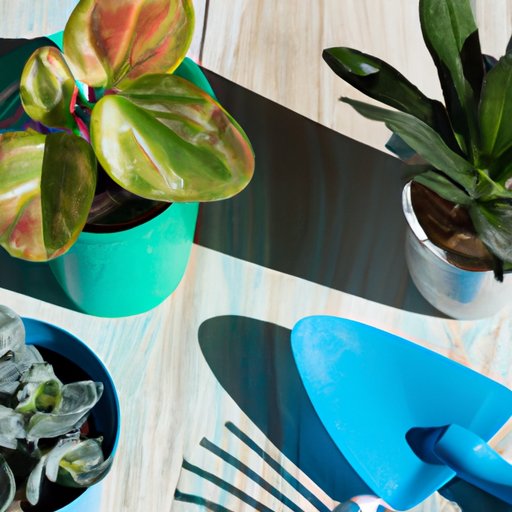Introduction
If you have recently developed an interest in gardening or are looking for low-maintenance indoor plants, succulents are an excellent choice. These attractive and versatile plants need minimal effort to thrive and can add a refreshing touch to your home decor and outdoor spaces. However, there are some crucial aspects to consider to ensure you provide the optimal care for your succulents. This article aims to impart useful tips and techniques to help you take care of succulents like a pro.
Understanding the Water Needs of Succulents
Succulents have unique water requirements compared to other plants. They store water in their leaves and stems, making them capable of tolerating prolonged periods of drought. However, over-watering can be extremely harmful to succulent health, often leading to root rot and other issues.
To ensure you give your succulents the optimal water, you must be careful not to water them too often. Typically, most succulent varieties need watering every two to three weeks. Before watering your plants, check the soil for dryness by poking your finger into the soil. If the top inch of the soil feels dry, it is time to water them.
When watering succulents, use a watering can or a hose to allow the water to soak the soil evenly. Avoid over-watering or soaking the soil as it can cause water to accumulate in the garden bed, leading to root rot. Additionally, ensure your planters have proper drainage holes to let excess water drain away.
Providing Adequate Sunlight
Succulents require abundant sunlight to thrive. These plants typically prefer bright light conditions of four to six hours a day. Placing them in a location with inadequate sunlight can result in stunted or leggy growth. On the other hand, exposing succulents to direct sunlight for prolonged periods can cause sunburn and other issues.
To ensure that you are providing adequate sunlight to your succulents, monitor your plants’ growth and look for signs of inadequate light conditions. Succulents that are not receiving enough sunlight will develop pale leaves or become stretched and elongated. If you notice these signs, consider adjusting the lighting conditions or relocating to a brighter spot gradually. Additionally, new plants should be gradually exposed to sunlight, starting with a few hours a day over a few weeks.
Choosing the Right Soil
Soil type is critical for succulent growth and overall health. When selecting soil for your succulents, consider factors such as drainage, texture, and aeration. Ideally, succulent soil should have excellent drainage capacity, good texture, and ample aeration for optimal growth.
You can prepare soil mix at home for your succulents by mixing coarse sand, peat moss, and perlite. Alternatively, commercial cactus soil mix is available in most gardening stores. Ensure that you mix the soil thoroughly, breaking up any lumps, to encourage proper aeration and drainage. Always use potting soil specifically formulated for succulents for better results.
Monitoring and Trimming Growth
Proper monitoring of succulent growth is crucial to ensure your plant’s continued health and vitality. Regular inspection of your plants for unhealthy growth or potential pests is essential. If you notice any unhealthy growth or leaf discoloration, consider trimming them safely to promote healthy growth.
To trim succulents safely, use a clean and sterilized pair of scissors or pruning shears. Ensure that you trim only the damaged or unhealthy growth and avoid leaving any stubs or scars. Proper trimming technique can help your succulent recover swiftly and promote healthy new growth.
Protecting Succulents from Pests and Diseases
Like most plants, succulents are susceptible to pests and diseases that can adversely affect their growth and overall health. The common pests that often target succulents are mealybugs, spider mites, and aphids. Common plant diseases include root rot, leaf spot, and powdery mildew.
To protect your plants from these pests and diseases, consider using organic remedies. You can use natural insecticides or soap solutions to keep pests at bay. Additionally, monitor your plants regularly to catch any signs of pest attacks or diseases early, which will make it easier to address the issues.
Potting and Repotting Succulents
Potting and repotting are critical aspects of succulent care. You must select the right planter size when potting your succulents. If the pot is too small, it can restrict root growth, while a pot that is too large can lead to overwatering.
When repotting your succulents, always use fresh potting soil mix, preferably formulated for succulents. Additionally, ensure that the new pot has proper drainage holes and that the old potting soil and any damaged or rotten roots are removed before repotting.
General Care Tips
Fertilization is an essential aspect of succulent care. During the growing season, you can feed your plants with a balanced, water-soluble fertilizer every four weeks. However, avoid fertilizing during the dormant season. Additionally, succulents are sensitive to temperature changes, so try to keep them away from drafty windows or doors. You can also enhance atmospheric conditions by misting your plants or using a humidifier to keep the air moist.
Other general care tips include regularly testing soil and water quality to ensure that your plants are receiving the optimal nutrients and reducing stress by providing consistent care and avoiding harsh growing conditions. Additionally, having proper gardening tools, such as watering cans, clean scissors, and soil testing kits, can make caring for your succulents much easier and more efficient.
Conclusion
In conclusion, taking care of succulents is easy and requires minimal effort. By following the tips and techniques highlighted in this article, you can ensure that your plants thrive and bring joy to your living spaces. Remember to provide optimal lighting and soil conditions, monitor your plants regularly, protect them from pests and diseases, and pot and repot them as necessary. With proper care, succulents can be a low-maintenance but fulfilling part of your indoor or outdoor garden.
Implement these tips, share your experience, and watch as your succulents flourish into healthy and robust plants, adding a refreshing touch to your environment.
